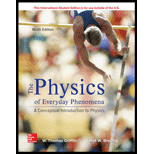
Concept explainers
A flat-bottomed wooden box is 2.8 m long and 1.3 m wide, with sides 1 m high. The box serves as a boat carrying five people as it floats on a pond. The total mass of the boat and the people is 1600 kg.
- a. What is the total weight of the boat and the people in newtons?
- b. What is the buoyant force required to keep the boat and its load afloat?
- c. What volume of water must be displaced to support the boat and its load? (The density of water is 1000 kg/m3.)
- d. How much of the boat is underwater? (What height of the sides must be submerged to produce a volume equal to that of part c?)
(a)
Total weight of boat and people.
Answer to Problem 4SP
The total weight of people and boat is
Explanation of Solution
Given info: length of boat is
Write the equation to find the weight.
Here,
Substitute
Conclusion:
The total weight of people and boat is
(b)
The buoyant force on the boat
Answer to Problem 4SP
The buoyant force is
Explanation of Solution
The buoyant force is equal to the weight of the water displaced.
Therefore buoyant force is
Conclusion:
The buoyant force is
(c)
The volume of water displaced.
Answer to Problem 4SP
The volume of water displaced by the boat is
Explanation of Solution
Write the equation to find the volume of water displaced.
Write the equation to find the density of boat.
Here,
Write te equation to find the volume of boat.
Here,
Substitute
Substitute
Substitute
Conclusion:
The volume of water displaced by the boat is
(d)
How much of boat is underwater.
Answer to Problem 4SP
Explanation of Solution
Volume of water displaced is equal to the volume of boat in the water.
Substitute
Conclusion:
Want to see more full solutions like this?
Chapter 9 Solutions
Physics of Everyday Phenomena
Additional Science Textbook Solutions
College Physics: A Strategic Approach (3rd Edition)
Human Physiology: An Integrated Approach (8th Edition)
Principles of Anatomy and Physiology
Fundamentals Of Thermodynamics
Loose Leaf For Integrated Principles Of Zoology
 College PhysicsPhysicsISBN:9781938168000Author:Paul Peter Urone, Roger HinrichsPublisher:OpenStax College
College PhysicsPhysicsISBN:9781938168000Author:Paul Peter Urone, Roger HinrichsPublisher:OpenStax College Physics for Scientists and Engineers: Foundations...PhysicsISBN:9781133939146Author:Katz, Debora M.Publisher:Cengage Learning
Physics for Scientists and Engineers: Foundations...PhysicsISBN:9781133939146Author:Katz, Debora M.Publisher:Cengage Learning
 Principles of Physics: A Calculus-Based TextPhysicsISBN:9781133104261Author:Raymond A. Serway, John W. JewettPublisher:Cengage Learning
Principles of Physics: A Calculus-Based TextPhysicsISBN:9781133104261Author:Raymond A. Serway, John W. JewettPublisher:Cengage Learning College PhysicsPhysicsISBN:9781285737027Author:Raymond A. Serway, Chris VuillePublisher:Cengage Learning
College PhysicsPhysicsISBN:9781285737027Author:Raymond A. Serway, Chris VuillePublisher:Cengage Learning College PhysicsPhysicsISBN:9781305952300Author:Raymond A. Serway, Chris VuillePublisher:Cengage Learning
College PhysicsPhysicsISBN:9781305952300Author:Raymond A. Serway, Chris VuillePublisher:Cengage Learning





